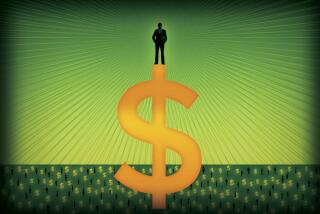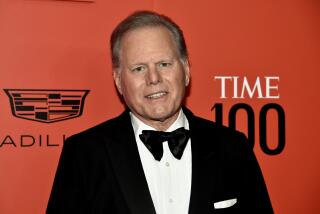Dividends Starting to Get More Respect
- Share via
Since Congress slashed the tax rate on dividend income one year ago, many U.S. companies have responded as expected: They’re handing shareholders more cold cash.
Now, there are increasing signs that investors are beginning to like the idea.
Big-name companies including Johnson & Johnson, Wal-Mart Stores Inc. and PepsiCo Inc. have sharply boosted their dividend payments over the last year, after Congress approved the Bush administration’s idea to drop the top tax rate on dividend income to 15% from 38.6%.
That reduction and other tax cuts President Bush signed into law in May 2003 were aimed in large part at putting more spending money in consumers’ pockets to lift the economy.
For much of 2003, the prospect of more dividend income didn’t seem to add much allure to companies’ stocks. In fact, the opposite frequently was true: Overall, the best-performing stocks last year were higher-risk issues that paid no dividends at all.
This year, however, many investors are taking a more conservative approach toward the stock market, and that is driving a new appreciation for established companies that pay dividends, some analysts say.
Within the blue-chip Standard & Poor’s 500 index, the 375 stocks that pay dividends are up 3.5% this year on average, said Howard Silverblatt, a researcher at S&P; in New York. The S&P; 500 stocks that don’t pay dividends, by contrast, are up 0.5% on average.
Last year, as Wall Street rebounded from the bear market of 2000 through 2002, the S&P; 500 stocks that don’t pay dividends were up nearly 62% on average, about double the gain of the dividend payers.
Some financial advisors say it’s beginning to sink in with many of their clients that cash dividends can provide significant returns over time -- and more so now that the top tax rate on that income is the lowest in more than a generation.
“I think it’s the most interesting thing that’s happened in financial markets in the last several years,” said Joseph Keating, chief investment officer at AmSouth Bancorp in Birmingham, Ala.
Rick Keller, head of Keller Group Investment Management in Irvine, said he has had “many more” individual clients asking questions about dividend income since the tax cut.
Some investors, however, say that cash dividend payments still are too low to get them excited.
The average annualized dividend yield of the S&P; 500 stocks is 1.7%. That’s not a lot of money; a 1.7% yield would mean an annual dividend of 68 cents a share on a $40 stock. Or put another way, 100 shares of that stock (a $4,000 investment) would pay $68 a year in dividends.
People who want or need income generally can find higher yields on other investments, such as municipal bonds. And for people whose assets primarily are in tax-sheltered retirement accounts, tax rates aren’t a consideration in any case.
What’s more, many people are conditioned to think of stocks as capital-gain-producing investments rather than income producers. That was reinforced during the long bull market of 1982 through 1999, as share prices soared and dividends became an afterthought.
“For the long term, I’m looking for appreciation primarily,” said Norm Langhout, a 73-year-old retired investor in Mar Vista.
Although he said he was pleased at tax time this year to see that he was keeping much more of his dividend income from stocks such as Citigroup Inc., dividends still are “only a bit of a factor” in his stock hunting, he said.
Many companies are hoping that investors like Langhout give more attention to dividends. Standard & Poor’s estimates that the S&P; 500 firms will pay out $183 billion in dividends this year, 24% more than in 2002.
Among the broader universe of U.S. companies, 667 raised their dividend payouts in the first four months of this year, nearly 14% more than did so in the same period last year, S&P; data show.
Some of the dividend increases since the tax law change have been dramatic. Hospital company HCA Inc., which had paid an annual dividend of 8 cents a share since 1994, this year boosted that to 52 cents, a 550% rise.
PepsiCo in March raised its annual cash payment from 64 cents a share to 92 cents, a 44% increase. Before that, the soft drink giant’s dividend increases had been incremental, usually 2 to 4 cents a share each year.
The tax law change hasn’t been the only factor driving dividends higher. Companies typically are more generous with dividends when corporate earnings are booming -- because dividends, after all, are paid from profit.
Earnings have reached record levels over the last 12 months, giving more companies the wherewithal to hand out bigger dividends, S&P;’s Silverblatt said.
Some Wall Street pros have been disappointed that dividends haven’t gone up faster.
“I think the increases have been small compared with the jump in earnings,” said Richard Bernstein, chief U.S. market strategist at Merrill Lynch & Co. in New York.
He noted that one goal of the tax law change was to encourage corporate managers to be better stewards of shareholders’ assets. If a company can’t find a compelling place to reinvest its profit, it now makes more sense to simply give it to shareholders through dividends and allow them to make the investment decision, Bernstein said.
“The dividend tax cut says to companies, ‘You shouldn’t retain cash -- you should pay it out as a dividend,’ ” said John Makin, a resident scholar at the American Enterprise Institute in Washington.
From a macroeconomic point of view, “it will improve resource allocation substantially over time,” he said.
Others aren’t so sure. Bernstein said the pressure on companies to pay bigger dividends would have been far greater if Congress, in cutting the top tax rate on dividend income, hadn’t also cut the rate on long-term capital gains.
The maximum capital gains rate was reduced to 15% from 20%. Because that is the same as the dividend tax rate, company managers can argue that it makes just as much sense to hold on to cash with the expectation of boosting the value of the business over time, and thus the share price, Bernstein said.
A bigger obstacle to higher dividend payments may be concern that the lower tax rates won’t last.
The Bush tax cuts on capital gains and dividends are set to expire in 2009 unless Congress extends them. With the federal budget deficit at record levels, many analysts say there is a risk that the cuts could be rescinded earlier.
“The problem with tax law has always been that it’s highly political and subject to manipulation,” Makin said.
*
(BEGIN TEXT OF INFOBOX)
Some of this year’s big dividend boosters
Here are 15 major U.S. companies that have raised their cash dividend payments by at least a double-digit percentage rate this year. Also shown are the stocks’ annualized dividend yields (annual dividend divided by the stock price) and the year-to-date price changes in the shares.
Annualized div. per share: Pctg. Fri. Div. Stock increase stock yield price Previous Now close chng. YTD Company HCA $0.08 $0.52 +550% $38.83 1.3% - 9.6% Intel 0.08 0.16 +100 28.55 0.6 -10.9 Wendy’s Intl 0.24 0.48 +100 37.79 1.3 -3.7 Devon Energy 0.20 0.40 +100 59.36 0.7 +3.7 PepsiCo 0.64 0.92 +44 53.37 1.7 +14.5 Wal-Mart Stores 0.36 0.52 +44 55.73 0.9 +5.1 Qualcomm 0.28 0.40 +43 67.07 0.6 +24.4 Avon Products 0.84 1.12 +33 88.66 1.3 +31.4 Paccar 0.60 0.80 +33 55.80 1.4 -1.7 Allstate 0.92 1.12 +22 43.98 2.5 +2.2 Limited Brands 0.40 0.48 +20 19.30 2.5 +7.0 Johnson & Johnson 0.96 1.14 +19 55.71 2.0 +7.8 Kimberly- Clark 1.36 1.60 +18 65.90 2.4 +11.5 Fannie Mae 1.80 2.08 +16 67.70 3.1 -9.8 Citigroup 1.40 1.60 +14 46.43 3.4 -4.3
S&P; 500 17.70 * 19.25 +9 1,120.68 1.7 +0.8
*Indicated rate at the start of the year Source: Standard & Poor’s
More to Read
Inside the business of entertainment
The Wide Shot brings you news, analysis and insights on everything from streaming wars to production — and what it all means for the future.
You may occasionally receive promotional content from the Los Angeles Times.










